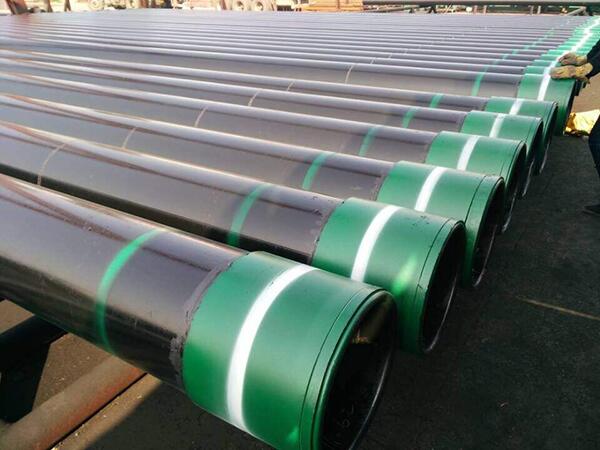
API 5CT Casing Inspection
Date:2024-04-29 keywords: api 5ct casing inspection, oil casing pipe
Oil casing pipe is a high-end product produced by steel pipes. There are many types of casings. There are 15 categories of casing diameter specifications, and the outer diameter range is 114.3-508mm; the steel grades are mainly divided into J55, K55, N80, L-80, P-110, C-90, C-95, T-95, etc. There are 11 types of casing pipe end buckle types and requirements. The buckle types that can be processed include STC, LC, BC, VAM and other buckle types.
The production and installation process of oil casing involves a lot of testing, mainly as follows:
1. Ultrasonic testing
When ultrasonic waves propagate in the material being tested, changes in the material's acoustic properties and internal organization have a certain impact on the propagation of ultrasonic waves. By detecting the degree and condition of the impact of ultrasonic waves, we can understand the changes in material properties and structure.
2. Radiographic detection
3. Penetration testing
Penetrant testing uses the capillary action of liquid to penetrate the penetrant into the open defects on the surface of solid materials, and then uses the developer to suck the penetrant out to the surface to reveal the existence of defects.
Penetration testing is suitable for various metal and ceramic workpieces, and the time from penetration operation to defect display is relatively short, generally about half an hour. It can detect surface fatigue, stress corrosion and welding cracks, and can directly measure the size of cracks.
4. Magnetic particle testing
Magnetic particle testing uses magnetic flux leakage at defects to absorb magnetic particles and form magnetic marks to provide defect display. It can detect surface and sub-surface defects. The nature of defects is easy to identify. Paint and electroplated surfaces do not affect detection sensitivity.
5. Eddy current testing
Eddy current testing mainly uses the eddy currents induced by ferromagnetic coils in the workpiece to analyze the internal quality of the workpiece. It can detect surface and near-surface defects of various conductive materials. Usually, it is difficult to control the parameters and the test results are difficult to interpret, and it requires detection objects. It must be a conductive crack and the length of the defect can be measured indirectly.
6. Magnetic flux leakage detection
Magnetic flux leakage detection of oil casing is based on the high magnetic permeability characteristics of ferromagnetic materials. It detects the quality of in-service oil casings by measuring changes in magnetic permeability caused by defects in ferromagnetic materials.
7. Magnetic memory detection
Magnetic memory detection is derived from the relationship between the physical nature of magnetic phenomena in metals and the dislocation process. It has many advantages such as high efficiency, low cost, and no need for polishing. It has important and wide application prospects in industry.
The production and installation process of oil casing involves a lot of testing, mainly as follows:
1. Ultrasonic testing
When ultrasonic waves propagate in the material being tested, changes in the material's acoustic properties and internal organization have a certain impact on the propagation of ultrasonic waves. By detecting the degree and condition of the impact of ultrasonic waves, we can understand the changes in material properties and structure.
2. Radiographic detection
Radiographic testing uses the difference in the amount of radiation transmitted through normal parts and defective parts to cause the difference in blackness on the film.

3. Penetration testing
Penetrant testing uses the capillary action of liquid to penetrate the penetrant into the open defects on the surface of solid materials, and then uses the developer to suck the penetrant out to the surface to reveal the existence of defects.
Penetration testing is suitable for various metal and ceramic workpieces, and the time from penetration operation to defect display is relatively short, generally about half an hour. It can detect surface fatigue, stress corrosion and welding cracks, and can directly measure the size of cracks.
4. Magnetic particle testing
Magnetic particle testing uses magnetic flux leakage at defects to absorb magnetic particles and form magnetic marks to provide defect display. It can detect surface and sub-surface defects. The nature of defects is easy to identify. Paint and electroplated surfaces do not affect detection sensitivity.
5. Eddy current testing
Eddy current testing mainly uses the eddy currents induced by ferromagnetic coils in the workpiece to analyze the internal quality of the workpiece. It can detect surface and near-surface defects of various conductive materials. Usually, it is difficult to control the parameters and the test results are difficult to interpret, and it requires detection objects. It must be a conductive crack and the length of the defect can be measured indirectly.
6. Magnetic flux leakage detection
Magnetic flux leakage detection of oil casing is based on the high magnetic permeability characteristics of ferromagnetic materials. It detects the quality of in-service oil casings by measuring changes in magnetic permeability caused by defects in ferromagnetic materials.
7. Magnetic memory detection
Magnetic memory detection is derived from the relationship between the physical nature of magnetic phenomena in metals and the dislocation process. It has many advantages such as high efficiency, low cost, and no need for polishing. It has important and wide application prospects in industry.
Among several detection methods, there is currently no special standard for product magnetic memory detection and has yet to be developed. The remaining six types have their own detection standards and are relatively mature.
Read more: What are the Grades of OCTG Casing Material?
News Update :
How to Distinguish the Quality of CS Seamless Pipes?...
©2017 Permanent Steel Manufacturing Co.,Ltd https://www.permanentsteel.com All Rights Reserved.
Terms of Sale|Privacy Policy


